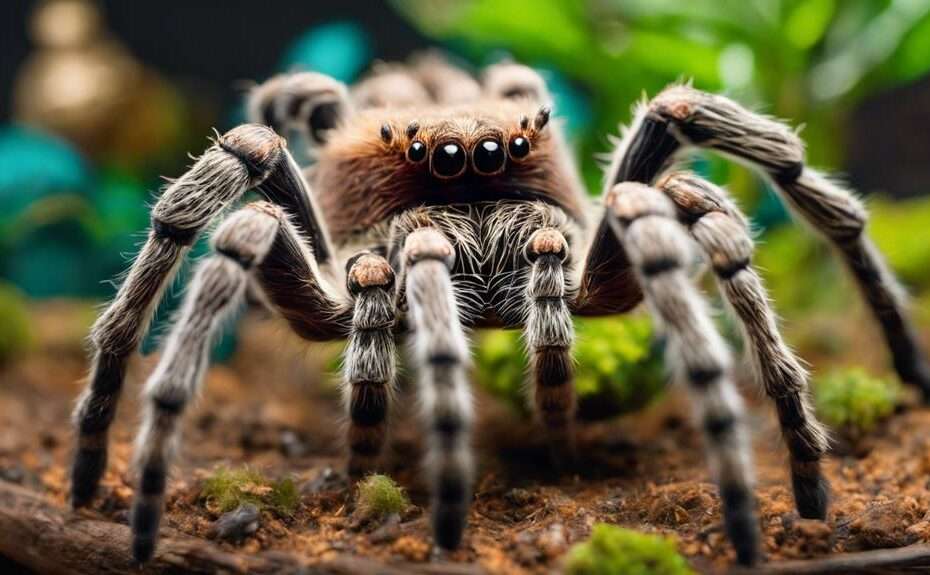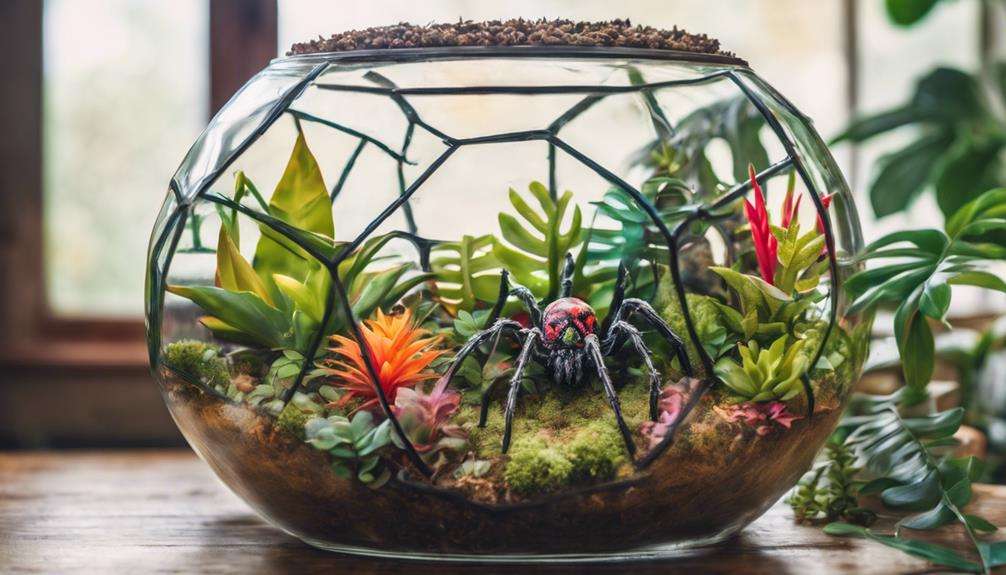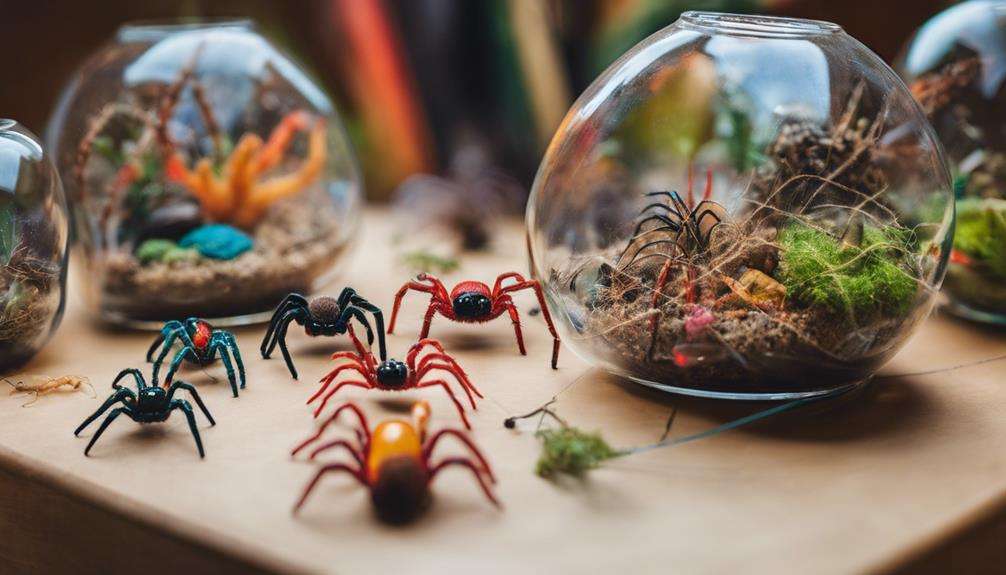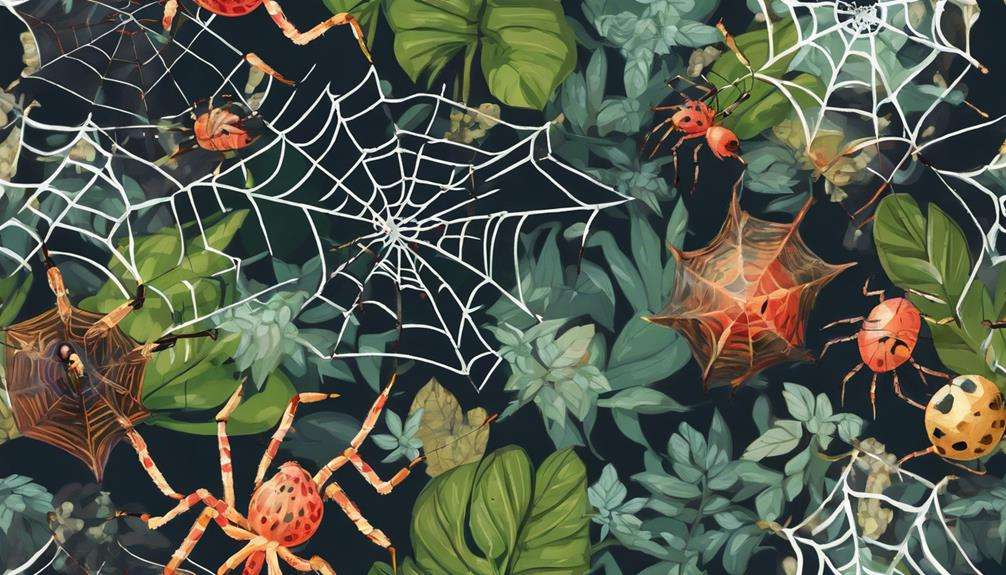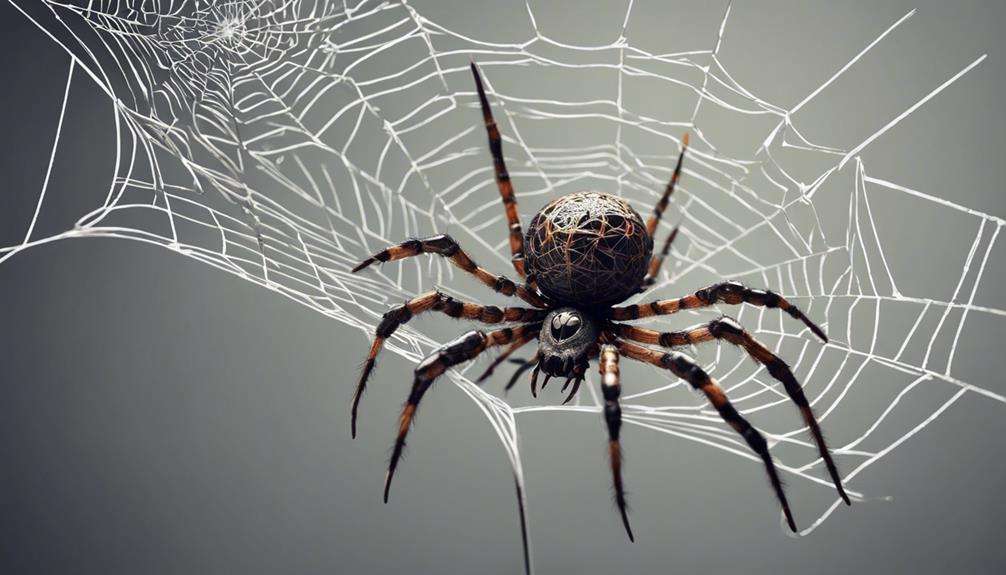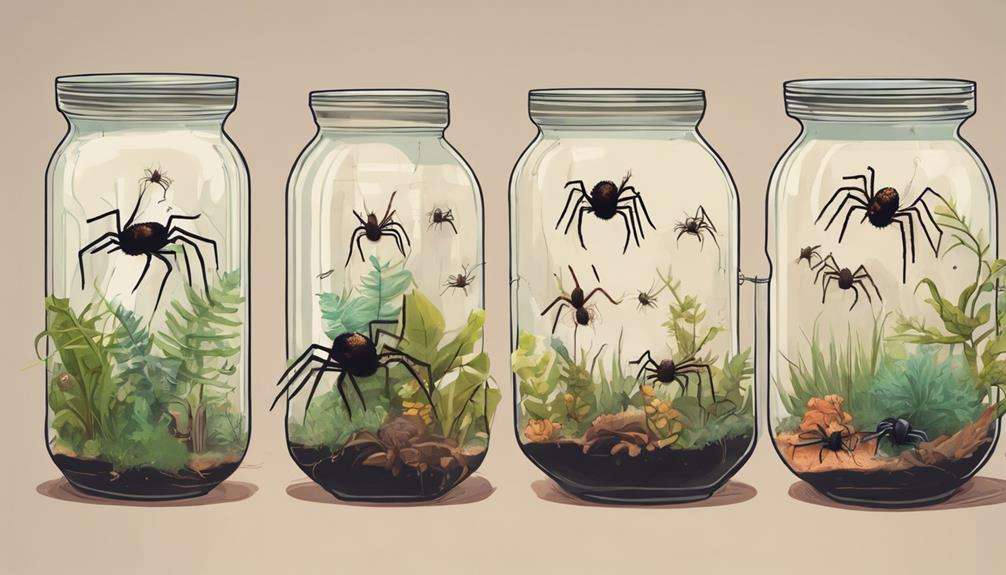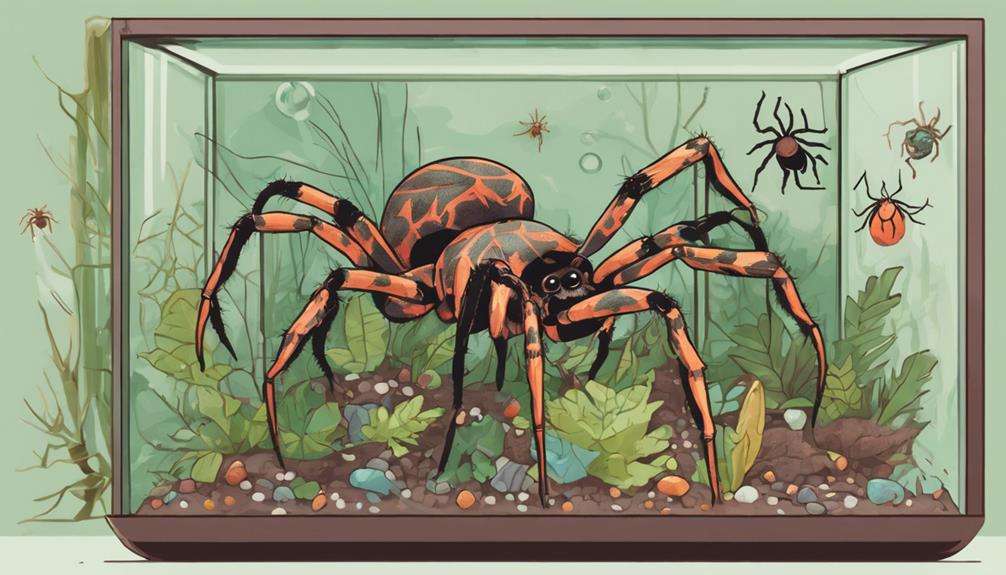Did you know that some spider species can make fascinating long-term companions as pets?
When considering which spider to welcome into your home, it might surprise you to learn that certain species can live for several decades, adding a unique dynamic to your household.
Understanding the longevity and care requirements of these arachnids is essential for creating a fulfilling and lasting relationship with your eight-legged friend.
Key Takeaways
- Chilean Rose Tarantulas have females living over 20 years, known for rose-colored hair.
- Chaco Golden Knee Spiders, originating from Argentina, can live 20-25 years.
- Proper care practices for spiders contribute significantly to their longevity.
- Female Texas Tan Tarantulas can live up to 40 years, making them long-living pets.
Top Long-Living Pet Spider Species
When considering long-living pet spider species, it's essential to focus on specific characteristics that contribute to their extended lifespans. Among the top choices for those seeking a pet spider with a long lifespan are the Texas Tan Tarantula, Brazilian Black Tarantula, Chaco Golden Knee Tarantula, Mexican Red Knee Tarantula, and Female Chilean Rose Tarantula.
Female Chilean Rose Tarantulas are known to live up to 20+ years, making them a popular choice. The Chaco Golden Knee Tarantula has an average lifespan of 20 to 25 years, showcasing their longevity. Brazilian Black Tarantulas, especially females, can live between 20 to 30 years, prized for their velvety black appearance and longevity. Mexican Red Knee Tarantulas, with females living up to 30 years, are striking pets with their black and red coloration.
Significantly, Texas Tan Tarantulas stand out with females living up to 40 years, making them one of the longest-living pet spider species, particularly in the United States.
Chilean Rose Tarantula Lifespan
Chilean Rose Tarantulas, scientifically known as Grammostola rosea, have intriguing lifespans that vary between genders, with females living longer on average than males. Originating from regions in Chile, Bolivia, and Argentina, these tarantulas are recognized for their distinctive rose-colored hair.
Understanding the growth stages, health requirements, and proper care for Chilean Rose Tarantulas is essential for ensuring their well-being and longevity as pets.
Growth Stages Overview
During their growth stages, Chilean Rose Tarantulas exhibit distinct changes in physical appearance and behavior as they progress through their lifespan. Females of the species, known as Grammostola rosea, have a longer lifespan of over 20 years in captivity, while males typically live up to 10 years.
These tarantulas, with their rose-colored hair, are visually distinctive creatures. As Chilean Rose Tarantulas mature, they undergo several growth stages where their size increases, and they molt to shed their exoskeleton. Critical is a part of their growth, allowing them to regenerate lost limbs and grow larger. This process is repeated several times throughout their lifespan, with each molt marking a new stage in their development.
Health and Care
For essential health and longevity of your Chilean Rose Tarantula, implementing appropriate care practices is vital. These tarantulas can live up to 15 to 20+ years for females and 3 to 10 years for males with proper care.
Guarantee suitable housing by providing a well-ventilated terrarium with substrate for burrowing and climbing. Feed them a diet of live insects like crickets and mealworms, ensuring they're appropriately sized.
Their distinctive rose-colored hair should be kept clean to prevent any health issues. It's critical to minimize handling to reduce stress and potential aggression in your Chilean Rose Tarantula.
Chaco Golden Knee Spider Longevity
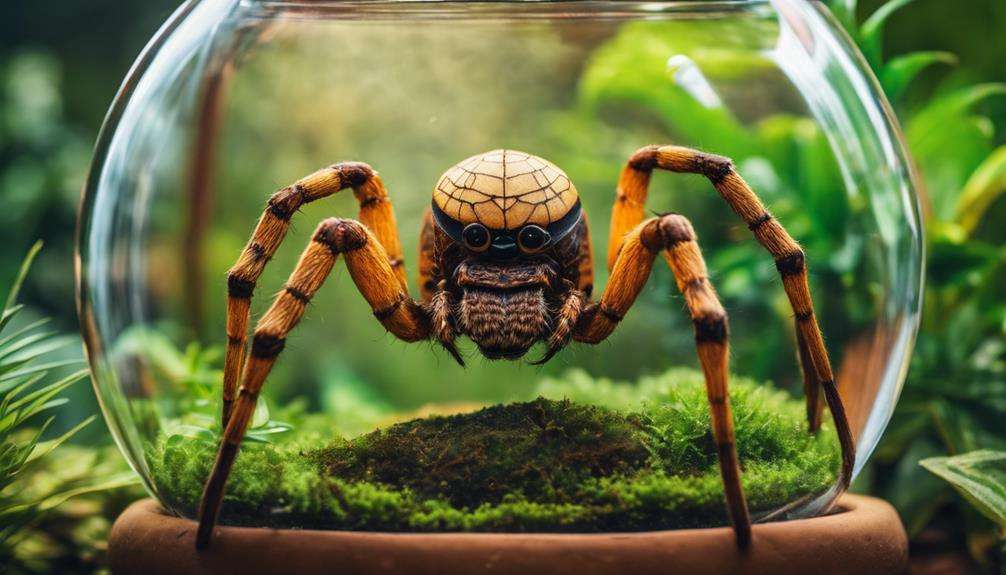
Chaco Golden Knee spiders, scientifically known as Grammostola pulchripes, have intriguing lifespans influenced by gender disparities. Females typically outlive males, with females surviving an average of 20 to 25 years, while males have a shorter lifespan of 5 to 10 years.
The longevity of these tarantulas raises questions about the factors contributing to their differing lifespans and how they adapt to maximize their time on Earth.
Lifespan of Chaco Golden Knee
With an average lifespan of 20 to 25 years for females and 5 to 10 years for males, the Chaco Golden Knee tarantula stands out as a long-lived arachnid species originating from Argentina and Paraguay. These spiders can grow up to 8.5 inches in size, making them quite impressive to observe.
As pets, Chaco Golden Knees are popular among beginners due to their manageable care requirements. Their reputation as aggressive eaters adds to their allure, showcasing their active nature.
If you decide to keep one of these striking spiders, you may notice them proudly displaying their golden knee markings while sitting out in the open, providing you with a fascinating glimpse into the world of these enthralling creatures.
Factors Influencing Longevity
Factors that influence the longevity of Chaco Golden Knee tarantulas include proper care practices such as providing suitable food and habitat conditions. In captivity, females of this species can live for an average of 20 to 25 years, while males have a shorter lifespan of about 5 to 10 years.
Beginners often choose Chaco Golden Knees as pets due to their long lifespan and relatively easy care requirements. These tarantulas are visually appealing with their striking golden markings on their legs.
To guarantee a long and healthy life for your Chaco Golden Knee tarantula, it's critical to create a stable and stress-free environment. By paying attention to their specific needs and maintaining proper care protocols, you can help maximize their longevity in captivity.
Brazilian Black Tarantula Long Lifespan
The Brazilian Black Tarantula, scientifically known as Grammostola pulchra, boasts an impressive average lifespan of 20 to 30 years for females and 4 to 6 years for males. These jet black tarantulas, native to regions of Brazil and Uruguay, are recognized for their striking appearance with velvety hairs covering their bodies. One key factor contributing to their long lifespan is their slow growth rate, taking between 4 to 8 years to reach adulthood. This extended maturation period plays a critical role in their longevity, allowing them to develop and thrive over decades.
In addition to their extended lifespan, Brazilian Black Tarantulas exhibit fascinating feeding behavior. They're voracious predators capable of consuming prey almost double their size, showcasing their efficiency in capturing and devouring food. This unique feeding behavior not only sustains them but also highlights their adaptability and survival skills in the wild. Understanding these aspects of their biology can provide valuable insights into caring for these intriguing arachnids as pets.
Mexican Red Knee Tarantula Lifespan
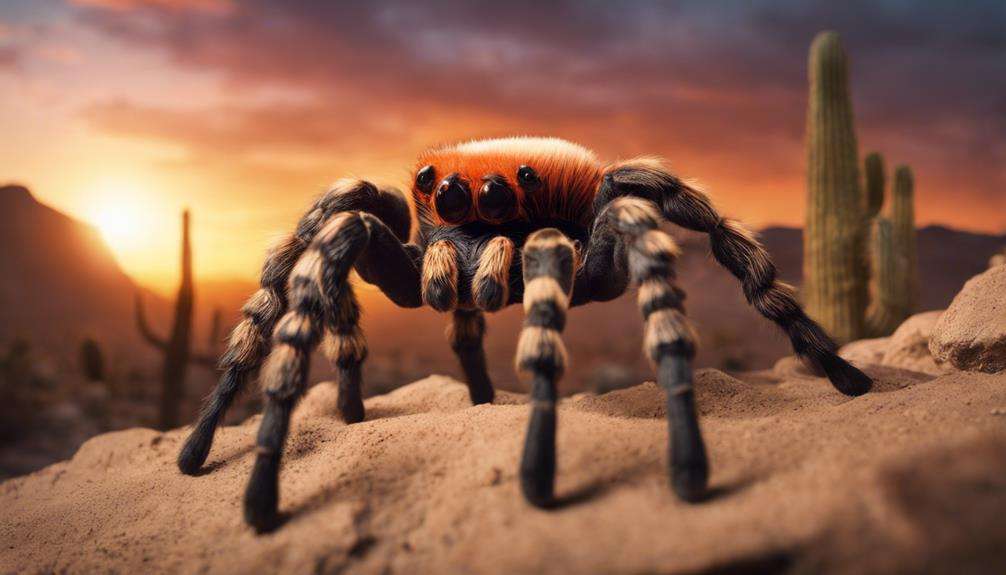
Reaching maturity at around 5 to 7 years old, Mexican Red Knee Tarantulas can live for up to 25 years or more in captivity. Females of the Mexican Red Knee Tarantula species generally have a longer lifespan compared to males. These striking arachnids are characterized by their black and dark brown bodies adorned with vibrant orange or dark red joints, making them a visually appealing choice for spider enthusiasts.
In their natural habitat, Mexican Red Knee Tarantulas tend to create their burrows in rocky areas, showcasing their preference for such environments. Unfortunately, the Mexican Red Knee Tarantula population is dwindling in the wild due to factors such as the pet trade and habitat destruction, leading to their classification as an endangered species.
As captives, providing a suitable habitat and proper care can help make sure these fascinating creatures live out their full potential lifespan in captivity.
Armored Trapdoor Spider: Ageless Arachnid
Armored Trapdoor Spiders, renowned for their remarkable longevity, exhibit intricate behaviors and survival adaptations that make them intriguing pets for arachnid enthusiasts. With some individuals living up to an impressive 43 years in captivity, these arachnids showcase a unique combination of long lifespan and specialized behaviors.
Their carefully constructed burrows with trapdoors highlight their survival adaptations, emphasizing their resilience and adaptability to controlled environments. The Armored Trapdoor Spider's ability to thrive for decades in captivity offers a rewarding experience for dedicated spider keepers.
Frequently Asked Questions
What Pet Spider Lives the Longest?
When caring for a pet spider, focus on selecting species like the Texas Brown Tarantula for longevity. Female tarantulas generally outlive males, with factors like environment, food, and predators playing a role in their lifespan.
What Is the Longest Living Spider in Captivity?
To help your pet tarantula live longer in captivity, make sure proper care with suitable housing and diet. Monitoring temperature, humidity, and handling techniques are key. Remember, female tarantulas generally outlive males.
What Is the Best Spider to Keep as a Pet?
For the best spider pet, consider tarantula care. Understand spider habitat, feeding, handling, behavior, species, terrarium setup, enrichment, and molting. Choose wisely for a fulfilling pet experience with a Brazilian Black Tarantula's long lifespan.
What Spiders Have Long Life Spans?
Spiders with long lifespans include the Texas Brown Tarantula, living up to 40 years. Various factors affect lifespan, like predators and environment. Female tarantulas are popular due to longer lifespans and egg-carrying ability.
Conclusion
You have now uncovered the secrets of the ancient arachnids, creatures of remarkable longevity and resilience. Like time-worn sentinels of the shadows, these pet spiders stand as monuments to the passage of time.
Through meticulous care and unwavering dedication, you have the power to nurture these ageless beings, watching them thrive and flourish in their captive kingdoms.
Embrace the wonder of their existence, for they're truly ageless wonders of the spider world.
